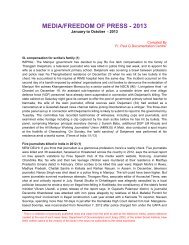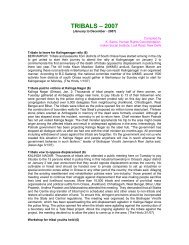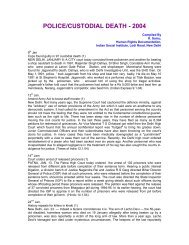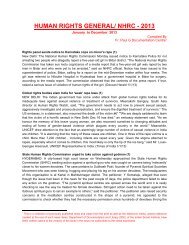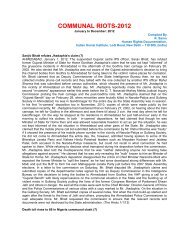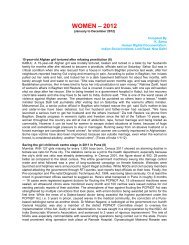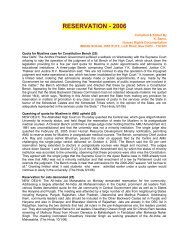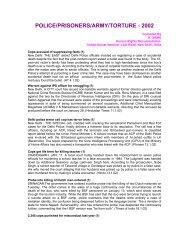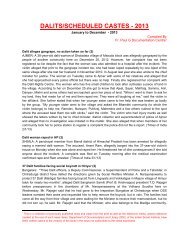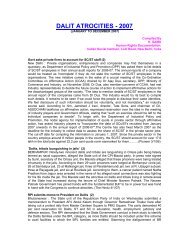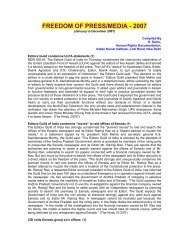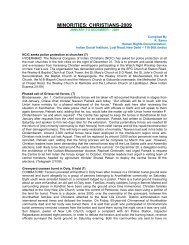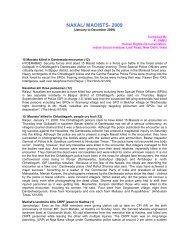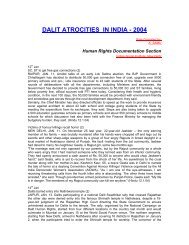NAXAL/ MAOISTS- 2010 - Indian Social Institute
NAXAL/ MAOISTS- 2010 - Indian Social Institute
NAXAL/ MAOISTS- 2010 - Indian Social Institute
You also want an ePaper? Increase the reach of your titles
YUMPU automatically turns print PDFs into web optimized ePapers that Google loves.
produced six of the “missing” tribals, SC had ordered a Delhi judge on Monday to record their statements.<br />
On Tuesday, a bench of justices B Sudershan Reddy and SS Nijjar directed the SC registry to give copies<br />
of the statements to the tribals’ counsel Colin Gonsalves and the central and the state governments.<br />
Gonsalves said the statements confirmed the massacre but did not apportion responsibility. During the<br />
hearing, attorney general Goolam E Vahanvati referred to home minister P Chidambaram’s statement<br />
that the government was ready to talk to Maoists, provided they abjured violence. “And the answer we<br />
have got yesterday [Monday] from Bengal,” Vahanvati regretted, referring to the killing of securitymen in<br />
West Midnapore. When lawyer Prashant Bhushan pointed out human rights violations by state agencies<br />
in their fight against Maoists in Chhattisgarh, solicitor general Gopal Subramanium intervened to say<br />
“nobody wanted to go [to fight Maoists] with a death band on the forehead. We do not want to perpetuate<br />
a situation like a civil war”. The judges pacified the solicitors, saying, “We are not on anything like war, but<br />
for solving the problem (sic).” Subramanium continued: “The fight against naxals is not based on any<br />
political line and the Centre and the Chhattisgarh government are equally concerned about human rights.”<br />
To this, the judges said though the court did not go by media reports, some reports were “really<br />
disturbing”. (DNA 17/2/10)<br />
With locals on their side, Maoists now striking at will (12)<br />
JHARGRAM/SILDA: Five attacks on security forces in six months. Thirty-two jawans killed, scores<br />
injured, arms looted, police patrols cowed. On the flip side, three crackdowns on Maoist dens. Just three<br />
suspected guerrillas killed, 190 arrested — 23 of them released to secure the freedom of abducted<br />
Sankrail OC Atindranath Dutta. It’s clear how the scales are tipped in the tussle between Maoists and<br />
security forces in the tribal belt of Jangalmahal. The side that has the locals’ support has the edge. The<br />
Maoists started winning one battle after another after November 2008, when the People’s Committee<br />
against Police Atrocities (PCPA) was formed. In January 2009, they started a police boycott in Lalgarh.<br />
With this began a systematic elimination of police informers. When the killing spree began, there were<br />
just 36 policemen in Lalgarh to police 300,000 people in 300 villages. It was the local information network<br />
that helped police in this impossible task. The guerrillas started targeting this system. Now, police stations<br />
are under lock-and-key and policemen don’t dare to venture out after dark even if there is a murder. The<br />
killings created a fear psychosis among the villagers, who retreated into a shell, refusing to share<br />
information with police. Occasional torture of villagers by police also turned people away from the<br />
lawkeepers. This strategy helped Maoists create a “liberated zone”, which gradually spread beyond West<br />
Midnapore, to Purulia and Bankura. The guerrillas also wooed villagers by digging wells, building roads<br />
and setting up health centres in this underdeveloped region. This helped them build a strong information<br />
system of their own that the forces do not have at the moment. The forces take a share of the blame, as<br />
well. After nine months in the region, they are still to come to grips with the terrain. They are not aware of<br />
the village paths that crisscross jungles. Till the first week of February, they didn’t even venture into the<br />
jungles, say sources, sticking to the roads for their 10 am to 3 pm patrols. In the past two weeks, they<br />
have started going into forests. A CRPF jawan said the situation is getting worse. “We marched into Silda<br />
last night around 8.30 pm. Since then till this afternoon we couldn’t even get water to drink. This is how<br />
we have been working every day,” he said. But there are other equally worrisome questions that remain<br />
unanswered. Why were most of the jawans without arms? Why were the men and women who lurked in<br />
the area for more than an hour not challenged? Some sources claim that Kishenji himself had been<br />
keeping watch on the Silda camp for two months. According to a CID official, it is high time the forces<br />
went for an “intelligence-backed guerrilla operation”. “You can beat guerrillas by fighting like a guerrilla.<br />
It’s an ideal situation for Cobra operation under the direct command and control of CRPF.” (Times of India<br />
17/2/10)<br />
Karnataka Naxal leader killed in police encounter (12)<br />
Karkala (Karnataka), March 1 : The Anti Naxal Force (ANF) gunned down a wanted Naxal leader Vasant<br />
Goudlu in an encounter near Muniyal in Karnataka's Udupi district on Monday evening. The ANF also<br />
believes that another wanted Naxal leader Vikram Goudlu and Vasant's sister Sundari managed to flee<br />
from the sight. On a tip-off police surrounded three Naxals in Maroli Jaddu forest area in Karkala taluk of<br />
the district. An ANF personnel was also injured in the encounter. Police recovered one self-loading rifle<br />
(SLR), three magazines and a handbag from the sight. The ANF and Udupi Police have launched a joint<br />
search operation in the forest area to capture the absconding Naxals. Vasant, a Malekudiya tribal hailed<br />
from Kutlur village in the Kuduremukh National Park area. The 30-year-old, who was an active member of<br />
the Karnataka Vimochana Ranga in 1990s, later went underground and became active in the Naxal<br />
movement. He was a staunch follower of the Maoist ideologue Saket Rajan and a member of the Maoist's<br />
Karavali Area Committee. Vasant's name figured in the 2003 Idu encounter and also in the bomb attack



